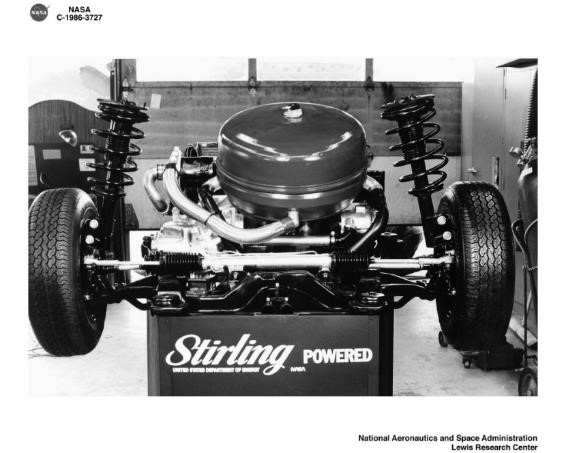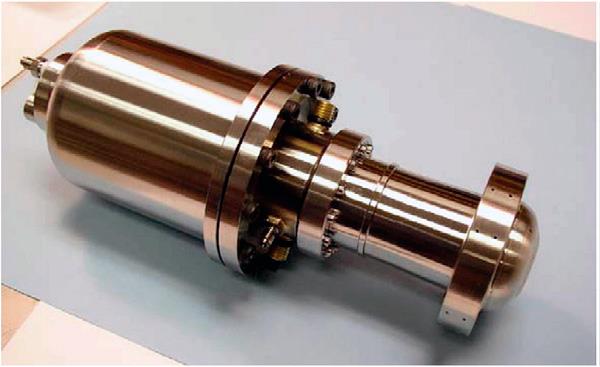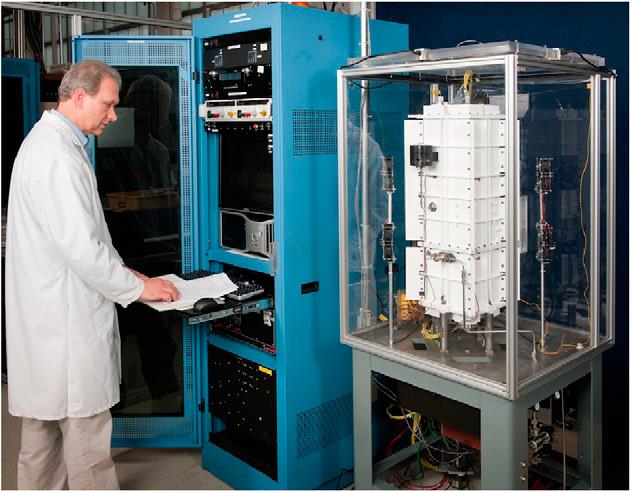Past Projects
ASRG
Development of Sunpower’s advanced Stirling convertor (ASC) was initiated under a NASA SBIR and later continued under the NASA radioisotope power conversion technology (RPCT) project. Key features of the ASC include gas bearings for non-contacting operation, a moving magnet linear alternator, and a planar spring to resonate the displacer. The first test unit was the frequency test bed (FTB) convertor that demonstrated a 36% conversion efficiency at a heater head temperature of 923 K and temperature ratio of 3. The follow-on ASC-1 unit, used a MarM-247 heater head and produced 88 We with 38% conversion efficiency at a hot-end temperature of 1,123 K, temperature ratio of 3.1, and operating frequency of 105 Hz. The ASC mass is approximately 1.3 kg per 75-W convertor, providing a factor of 5 improvement in convertor specific power over the TDC. The ASC has been incorporated into the advanced Stirling radioisotope generator (ASRG) that was being developed by the DOE and Lockheed Martin with support from the GRC. An ASRG engineering unit (EU) was completed in 2008, using two ASC-E units in an opposed configuration similar to the flight design, but using Inconel 718 heater heads rather than MarM-247. The ASRG EU produces about 130 W at approximately 25% gross system efficiency with the Stirling convertors at 883 K hot-end and 333 K cold-end temperatures (temperature ratio of 2.7). The EU underwent an extensive test campaign at Lockheed Martin including thermal balance, thermal vacuum performance, mechanical disturbance, sine transient, random vibration, simulated pyrotechnic shock, and electromagnetic interference before it was delivered to the GRC, where it was placed in extended-operation testing. In late 2013, the ASRG project was cancelled, and testing of the EU ended. However, 24/7 testing of ASC and other type free-piston Stirling convertors continues. As of March of 2020, over 1.1 million hours of total test time has been logged in the Stirling Research Lab at GRC.
Stirling Radioisotope Generator (SRG-110)
In the late 1990s, the GRC and Stirling Technology Company (STC) developed the technology demonstration convertor (TDC), initially through a NASA SBIR contract and then through a follow-on DOE contract. The TDC was a 55-W free-piston convertor with flexure bearings for non-contacting operation and was designed to operate in a dual-opposed pair to achieve dynamic balance with heat input from two GPHS modules. The design hot-end temperature was 923 K, and the cooler temperature was 333 K (temperature ratio of 2.8). The linear alternator used neodymium-iron-boron magnets and operated at 80 Hz. The convertor design life was in excess of 100,000 hours, sufficient to accommodate long-duration outer planet science missions up to 14 years. The TDC mass was 4.5 kg per 55-W convertor. The TDC was designated as the baseline convertor for the 110-W Stirling radioisotope generator known as the SRG110, developed by Lockheed Martin under contract to the DOE.
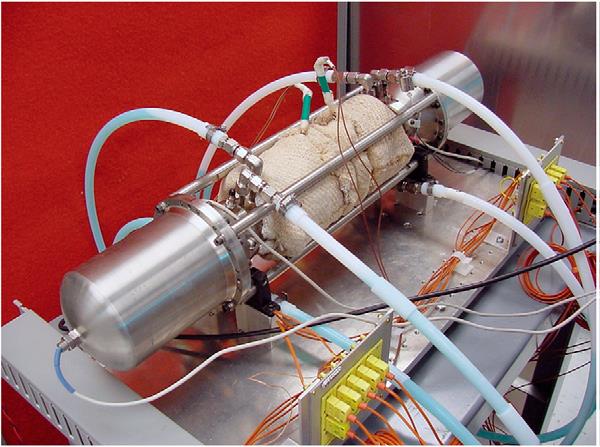
This project produced many Stirling convertors to address manufacturability, performance, life, and reliability. By the end of the project, Infinia (formerly STC) had built approximately 20 convertors. The GRC conducted most of the ground testing and supporting technology development for the SRG110 project and continues life testing today. In total, more than 500,000 hours of testing have been accumulated on the Infinia convertors in air and in a thermal vacuum environment, with one pair having operated for more than 110,000 hours. All of the convertors operated without performance degradation or component failure. The SRG110 had a projected system-specific power of approximately 3.5 We/kg.
Messenger
The MESSENGER (Mercury Surface, Space Environment, Geochemistry, and Ranging) spacecraft, launched in August 2004, performed two flybys of Venus followed by three flybys of Mercury before entering a year-long orbit in March 2011, followed by many eight-hour orbits beginning in April 2012 of the planet. The mission provided an opportunity for detailed characterization of the surface, interior, atmosphere, and magnetosphere of the closest planet to the sun. The NASA Glenn Research Center and the MESSENGER spacecraft integrator, the Johns Hopkins University Applied Physics Laboratory, partnered under a Space Act Agreement to characterize a variety of critical components and materials under simulated conditions expected near Mercury. Glenn’s Vacuum Facility 6, which was equipped with a solar simulator, was used to simulate the vacuum and high solar radiation anticipated in Mercury orbit.
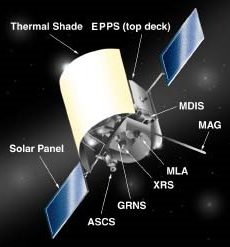
The MESSENGER test hardware included a variety of materials and components that were characterized during the Tank 6 vacuum tests, where the hardware was exposed to up to 11 suns insolation, simulating conditions expected in Mercury orbit. In 2002, ten solar vacuum tests were conducted, including beginning of life, end of life, backside exposure, and solar panel thermal shock cycling tests. Components tested include candidate solar array panels, sensors, thermal shielding materials, and communication devices. As an example, for the solar panel thermal shock cycling test, two candidate solar array panels were suspended on a lift mechanism that lowered the panels into a liquid nitrogen-cooled box. After reaching -140 °C, the panels were lifted out of the box and exposed to the equivalent of 6 suns (8.1 kW/m2). After five cold soak/heating cycles were completed successfully, there was no apparent degradation in panel performance. A 100-hr thermal shield life test was conducted followed by solar panel flight qualification tests. Glenn’s support to the MESSENGER program was instrumental in identifying design solutions and validating thermal performance models under a very aggressive development schedule. The test data assisted Johns Hopkins engineers in selecting a flight solar array vendor and a thermal shield design.
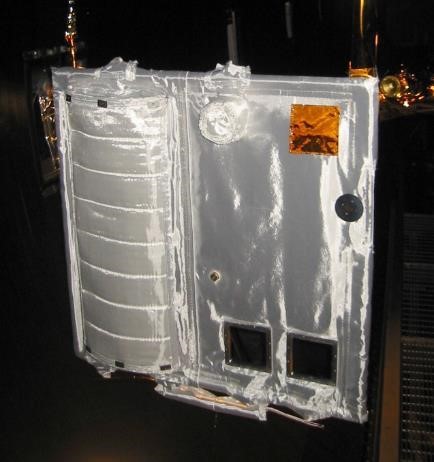
Solar Inflatable Concentrators
Thin-film inflatable solar concentrators offer significant advantages in comparison to state-of-the-art rigid panel concentrators, including low weight, low stowage volume, and simple gas deployment. From June 10 to 22, 2001, the ElectroMagnetic Radiation Control Experiment (EMRCE) Team used simulated solar energy to demonstrate the operation of an inflatable concentrator system at NASA Glenn Research Center’s Tank 6 thermal vacuum facility. The joint Government/industry test team was composed of engineers and technicians from Glenn, the Air Force Research Laboratory, SRS Technologies, and ATK Thiokol Propulsion. The research hardware consisted of the following:
- A thin-film inflatable concentrator. This concentrator made of CP-1, a NASA developed, flight-qualified polyimide material was designed and fabricated by SRS Technologies as part of a Glenn Small Business Innovation Research Phase II contract. The concentrator has a front clear canopy film and a rear aluminum-coated reflector film. The two films are seamed at the edges and are held to the support ring using a network of catenaries. For the EMRCE test, a rigid aluminum ring was used to decouple the effects of the inflatable concentrator with that of the usual inflatable, thin-film torus support structure. The concentrator is elliptical to account for the diverging beam from the solar simulator.
-
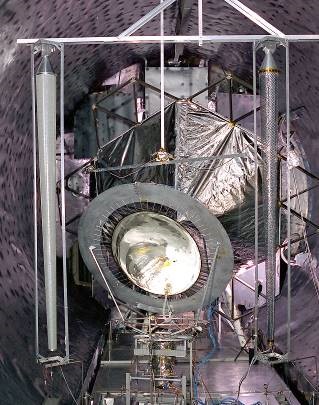
Inflatable Solar Concentrator in GRC’s VF-6 Solar Thermal Vacuum Facility The hexapod pointing and focus control system. The concentrator struts are mounted on this 6-degree-of-freedom, electrical-actuator-driven, remote-controlled base. The hexapod system was developed by ATK Thiokol Propulsion.
- Two rigidized support struts using two candidate technologies–ultraviolet-rigidized glass and radiation-cured isographite. In space, the struts would be gas deployed and would only require pressurization until rigidization was complete. For this test, the struts developed by ATK Thiokol Propulsion were not attached to the other hardware so that their behavior could be isolated.
With 1-sun illumination, the 1-m-class inflatable concentrator throughput power was measured to be 685 W, within 10 percent of predictions. Other objectives achieved include the first demonstration of the hexapod focus and pointing control system in a thermal vacuum environment, thermal and geometric response characterization of the inflatable concentrator as well as the thin-film rigidized support struts, and shape measurement photogrammetry of the concentrator during the test.
Solar Dynamic Ground Test Demonstration (SD GTD)
In the mid-1980s, space Brayton technology was revived for NASA’s Space Station Freedom (SSF) project (1986–1991). A 25-kWe solar dynamic (SD) power module was planned as part of a hybrid photovoltaic/solar dynamic power architecture. The SSF SD Brayton system included a faceted mirror concentrator and solar heat receiver with integral thermal energy storage that eliminated the need for rechargeable batteries for orbital eclipse power. The system was designed to produce 36 kWe at the alternator with a turbine inlet temperature of 1,034 K, compressor inlet temperature of 338 K, and maximum pressure of 560 kPa. The 32,000 rpm turboalternator was a scaled version of the BRU and mini-BRU, designed for helium-xenon working fluid (MW 40 g/mol). The system included a 94% effective recuperator and a separate n-heptane gas cooler. Final designs were completed by Allied Signal (formerly AiResearch), but no Brayton hardware was fabricated. Mass estimates were 104 kg for the turboalternator, 162 kg for the recuperator, and 85 kg for the gas cooler. Although the SSF SD system was never completed, NASA was able to demonstrate the technology via the solar dynamic ground test demonstration (SD GTD) project.

The system used the 2 kWe mini-BRU components and added a U.S. Air Force gas cooler coupled to a pumped n-heptane radiator. The concentrator and receiver were scaled versions of the SSF designs, and the receiver included integral LiF-CaF2 thermal energy storage for continuous sun-eclipse power generation via the Brayton power unit. The GTD project compiled more than 800 hours of operation and 372 simulated orbit cycles during 33 separate tests. Although the project objectives centered on the demonstration of the SD system technology, the testing confirmed the viability of Brayton for space systems regardless of the heat source used.
High Power Free-Piston Stirling
The first generation of hardware in the Large Free-Piston Stirling Engine (12.5 kW per cylinder) program, was the Space Power Demonstrator Engine (SPDE). The SPDE was a free-piston Stirling engine coupled to a linear alternator. It was a double cylinder, opposed-piston convertor designed to produce 25 kWe at 25% overall efficiency. After demonstration, the SPDE was modified to form two separate, single-cylinder power convertors called the Space Power Research Engines (SPRE).
The SPRE has a design operating point of 15.0 MPa using helium as the working fluid. The 650 K hot-end temperature and 325 K cold-end temperature provide an overall temperature ratio of 2. Piston stroke is 20 mm and operating frequency is about 100 Hz. The SPRE incorporates gas springs, hydrostatic gas bearings, centering ports, and close clearance non-contacting seals.
The second generation of hardware, the Component Test Power Convertor (CTPC), was to be a 25 kWe modular design consisting of two 12.5 kWe/cylinder opposed piston convertors. Only one-half of the CTPC was fabricated and tested. During the first-fully functional test of the CTPC, the design goals of 12.5 kWe output power and 20% overall efficiency were easily surpassed.
The mean helium working gas pressure of the CTPC is 15.0 MPa, Heater temperature is 1050 K and cooler temperature is 525 K. The pistons oscillate at 70 Hz. The novel “Starfish” heat-pipe heater head design greatly reduced the number of braze joints, relative to the SPDE tubular heater design.
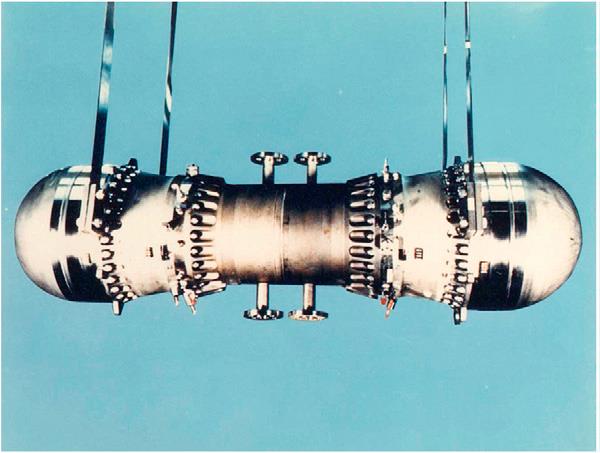
Automotive Stirling
The objectives of the Automotive Stirling Engine (ASE) Development project were to transfer European Stirling engine technology to the United States and develop an ASE that would demonstrate a 30% improvement in combined metro-highway fuel economy over a comparable spark ignition (SI) engine in the same production vehicle. In addition, the ASE should demonstrate the potential for reduced emissions levels while maintaining the performance characteristics of SI engines. Mechanical Technology Incorporated (MTI) evolutionarily developed the ASE, starting with the test and evaluation of an existing stationary Stirling engine and proceeding through two experimental engine designs: Mod I and Mod II. Engine technology development resulted in the elimination of strategic materials, increased power density, higher temperature, and efficiency operation, reduced system complexity, long-life seals, and low-cost manufacturing designs. Mod II engine dynamometer tests demonstrated that the engine system configuration had accomplished its performance goals for power (60 kW) and efficiency (38.5%) to within a few percent.
Tests with the Mod II installed in a delivery van demonstrated a combined fuel economy improvement consistent with engine performance goals and the potential for low emissions levels. A modified version of the Mod II was identified as a manufacturable ASE design for commercial production. In conjunction with engine technology development, technology transfer proceeded through two ancillary efforts: the Industry Test and Evaluation Program (ITEP) and the NASA Technology Utilization (TU) project. The ITEP served to introduce Stirling technology to industry, and the TU project provided vehicle field demonstrations for third-party evaluation in everyday use and accomplished more than 3100 hours and 8,000 miles of field operation. To extend technology transfer beyond the ASE project, a Space Act Agreement between MTI and NASA-Lewis Research Center allowed utilization of project resources for additional development work and emissions testing as part of an industry-funded Stirling Natural Gas Engine program.
